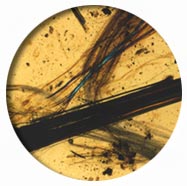 Crocidolite is the asbestiform variety of riebeckite. Riebeckite is the name used for minerals of the glaucophane-crossite-riebeckite series in which iron is predominant over magnesium and aluminum. Crocidolite is called the "Blue Asbestos", because it is strongly pleochroic, ranging from Prussian blue and indigo blue to yellow green. This distinctive pleochroism, and a negative sign of elongation, contrast with other types of asbestos. There are many minerals that may be fibrous with a negative sign of elongation (apatite, aragonite, some zeolites, etc.) The strong absorption and pleochroism are usually the first things one sees under plane light. Under crossed polars, the strong absorption colors tend to mask the low birefringence of the mineral. Anomalous orange-red interference colors are often visible.Riebeckite is monoclinic, but crocidolite fibers often show parallel extinction, similarly to amosite (see above), although it is not uncommon to find extinction angles of up to 20°. The characteristic form of crocidolite is similar to that of chrysotile. The fibers generally resemble strands of fine textured hair and are slightly more brittle than chrysotile, but can usually bend beyond 90° before breaking. Typically curved, hairlike, but straight fibers and bundles may also be found. Riebeckite cleavage fragments may be found in association with true asbestiform bundles. Crocidolite is harder than the other varieties of amphibole asbestos. Crocidolite is the asbestiform variety of riebeckite. Riebeckite is the name used for minerals of the glaucophane-crossite-riebeckite series in which iron is predominant over magnesium and aluminum. Crocidolite is called the "Blue Asbestos", because it is strongly pleochroic, ranging from Prussian blue and indigo blue to yellow green. This distinctive pleochroism, and a negative sign of elongation, contrast with other types of asbestos. There are many minerals that may be fibrous with a negative sign of elongation (apatite, aragonite, some zeolites, etc.) The strong absorption and pleochroism are usually the first things one sees under plane light. Under crossed polars, the strong absorption colors tend to mask the low birefringence of the mineral. Anomalous orange-red interference colors are often visible.Riebeckite is monoclinic, but crocidolite fibers often show parallel extinction, similarly to amosite (see above), although it is not uncommon to find extinction angles of up to 20°. The characteristic form of crocidolite is similar to that of chrysotile. The fibers generally resemble strands of fine textured hair and are slightly more brittle than chrysotile, but can usually bend beyond 90° before breaking. Typically curved, hairlike, but straight fibers and bundles may also be found. Riebeckite cleavage fragments may be found in association with true asbestiform bundles. Crocidolite is harder than the other varieties of amphibole asbestos.

Crocidolite as seen under polarized light

Crocidolite as seen under polarized light
|